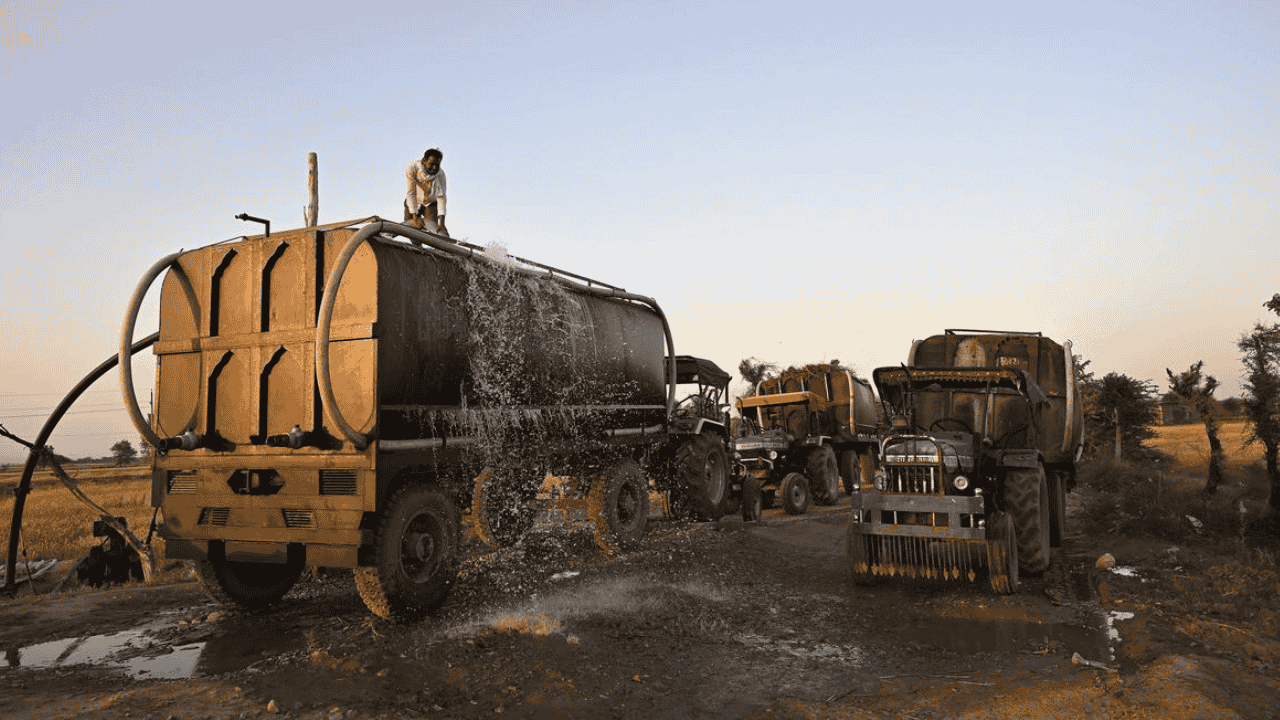Explore how groundwater pollution in Haryana has forced villagers to build underground tanks and depend on tankers. A key issue for UPSC & SSC exams.
The Battle Beneath: Haryana’s Underground Water Crisis
The groundwater crisis in Haryana has taken a dangerous turn — especially in Nuh district — where salty, toxic groundwater has pushed rural households to invest in expensive underground water tanks (kundas). This alarming situation connects multiple dimensions — climate change, public health, infrastructure, and governance failure — making it a crucial topic in any competitive exam blog, including for UPSC, SSC, and banking aspirants.
The Story of Ikhal Khan: A Struggle for Clean Water
Ikhal Khan, a 60-year-old resident of Ghaghas village, recalls fetching clean well water decades ago.
Over time, with groundwater depletion and salinity increase, villagers like him were forced to build kundas — underground tanks costing ₹1.6 lakh or more.
With aid from the Block Samiti, Khan built a 20,000-litre tank — used exclusively for drinking.
"The groundwater has become so salty, even birds avoid it," says activist Rajuddin Meo, convener of Mewat RTI Manch.
Why Haryana’s Groundwater is Dangerous
According to the 2024 Annual Ground Water Quality Report by the Central Ground Water Board (CGWB):
Haryana ranks 2nd in India for excessive fluoride contamination
208 out of 879 samples had fluoride above permissible limits
Arsenic and uranium levels also breached safety levels
Chronic exposure may cause fluorosis, cancer, and kidney failure
19 districts showed high electrical conductivity (EC), indicating salinity and chemical contamination
📌 UPSC preparation tip: Link this with GS Paper 3 (Environment & Health), and topics like water management and sustainable agriculture.
Ground Reality: Tankers, Sharing, and Struggle
200+ tanks have been built in Ghaghas, many shared by 3–4 families.
A private water tanker costs ₹1,200 in winter, and up to ₹12,000 in summer.
There’s often a 5–6 day waiting period.
For those below poverty line, this cost is unmanageable.
In villages like Madhi and Kheri Khumar, many depend on intermittent piped water (often once every 3 days, for just 10 minutes).
Government Response vs Ground Truth
Official Claims:
Public Health Engineering Minister Ranbir Gangwa claimed piped water access in all districts.
CM Nayab Saini reaffirmed commitment to clean water access under Jal Jeevan Mission.
Reality on Ground:
Villagers say pipelines are laid, but testing is still ongoing, and no regular supply is available.
BSNL-like rural water utility setups are missing.
Activist Meo highlights 26 out of 68 villages in Nagina block are severely hit.
Causes of Groundwater Pollution in Haryana
According to the CGWB report, key reasons include:
Overuse of chemical fertilizers and pesticides
Industrial and domestic waste mismanagement
Over-extraction of groundwater
Leakage from landfills and sewage lines
This has made groundwater unfit not just for drinking, but also irrigation in many areas.
Community Adaptations: Survival Tactics in a Thirsty Land
Villagers share tanks and rely on rainwater and tanker deliveries
Some panchayats have purchased their own tankers for collective use
Cattle rearing and driving jobs supplement incomes for marginal farmers
"We keep pots of tanker water even for birds — the groundwater burns our skin," says Irfan Khan, a diploma holder from Nuh.
Expert Voices: What Needs to Be Done
Shiv Singh Rawat (Former Engineer, Haryana Irrigation Dept.)
Advocate of Yamuna Bachao Abhiyan
Recommends:
Aquifer recharge using floodwater
Large-scale rainwater harvesting
Wastewater reuse
Crop diversification
Climate-resilient infrastructure
Public awareness and inter-state cooperation
Key Facts for Competitive Exams
Fluoride, arsenic, uranium contamination widespread in Haryana groundwater
Nuh is among NITI Aayog’s 100 Aspirational Districts
2024 CGWB report based on 15,259 samples
200+ kundas built in Ghaghas village
TDS levels in 70 of 860 borewells in Nuh exceeded 2,000 mg/litre
Jal Jeevan Mission pipelines laid, but no regular supply in many areas
Groundwater salinity causes skin issues; unfit for even bathing
Seasonal spike in tanker water prices and shortage
Why This Matters for Aspirants
This topic touches upon core themes for UPSC Mains (GS Paper 2 and 3), including:
Water resource management
Rural infrastructure gaps
Public health and environment
Inter-government coordination
Grassroots governance and community resilience
In SSC, Banking, and other exams, expect MCQs on:
Jal Jeevan Mission
CGWB
Groundwater pollution causes
Fluoride/arsenic contamination
👉 Stay updated on such issues through the Atharva Examwise blog, your trusted platform for banking exam insights, UPSC preparation tips, and daily GK updates.








